1. Introduction
[1.1] Although it is not a new practice (see Coker 2017), there has been an apparent recent upsurge in interest in the practice of fan binding, whereby fans create physical printed copies of works of fan fiction. This is evident in a number of recent academic publications discussing the topic (Kennedy 2022; Buchsbaum 2022) but also a seemingly increased interest in this form of transformative work in online fan communities. This may in part be due to the formation of large information-sharing communities such as the Renegade Bindery Discord server (Kennedy 2022), as well as a greater uptake in practical craft hobbies during the Covid-19 pandemic, when many fans were restricted from their normal activities.
[1.2] This heightened focus on fan binding is certainly evident in the microfandom surrounding Down to Agincourt, a series of novel-length fan fiction works begun in 2012 by the fan author Seperis and inspired by Supernatural (2005–20). This fan fiction has itself gathered an active fan community and inspired a large number of subsequent spin-off works (Stein 2018). Prior to 2020, there had been limited production of fan-bound versions of this work, including a small print run of a paperback copy of the first book typeset by a fan with professional book production experience and individuals printing their own copies for personal use. However, a new wave of interest in the story took place in 2020 (due in part to new installments being published after a long hiatus) accompanied by a notable increase in fan binding activity. This included a multiplicity of illustrated covers being produced, individuals learning book binding skills to create hand-bound, bespoke objects, and the distribution of typeset files to be used with print-on-demand services.
[1.3] We explore questions relating to why and how fans create and own physical copies of fan works. To do this, we describe the different forms of fan binding practice we have observed and documented within the fan community of Down to Agincourt. This is in contrast to prior academic work on fan binding, which takes a wider look at the practice. We argue that fan binding acts as a particular form of transformative work. We also examine this as design practice, taking a design research approach to examine the different factors—aesthetic, affective, practical, and iterative—that influence design decisions made during the production and distribution process of these works.
2. Context
[2.1] Books as a form of technology (note 1) have a long history, spanning thousands of years and multiple materials (Haslam 2006). The history of printing and the development of the book as object have had major societal impacts and lent a permanence and fixedness to narratives (Dean 2019). A multitude of design careers in the publishing industry include typographical design, layout, and visual design practices. Many new avenues for the design and publishing of written and related material have arisen with the introduction of digital technologies. Dean (2019, 34) suggests that "where print technologies led to a sense of the fixedness and authority of texts written by individual authors, digital technologies enable the creation of more flexible and collaborative texts." This is certainly true in fan spaces, as exemplified by the Archive of Our Own (AO3), which is notable in having been developed in a process described by Fiesler, Morrison, and Bruckman (2016) as being built upon "feminist human-computer interaction design values," that is, value-based approaches that consider fluid solutions. AO3 offers many affordances that allow such fluidity of its born-digital texts, including the capacity to serialize, update, and extend texts, embed multimedia and hyperlinks, and ascribe metadata including the highly complex and effective tagging system, which supports creativity through its folksonomic structuring (Price 2019).
[2.2] Why, then, is there a turn back to fan use of printed media and the technologies of the book? Buchsbaum (2022, ¶ 1.4) suggests that "For fan binders, making physical art objects counters obsolescence and data loss and provides a break from the screen, traversing a porous boundary between digital and physical fandom and a similar one between digital and material texts." Buchsbaum's use of the term "art objects" nods toward the fact that while books are functional technologies, they serve a variety of needs, only one of which is reading. Kennedy (2022) contextualizes the practice of creating bound volumes of fan fiction that echo traditional books within the long history of distributing printed materials in relation to fan activity, from 1930s fanzines onward. Versaphile (2011) notes that zines "may have a much lower initial circulation, but hard copies have a permanence that newsgroup posts, mailing-list e-mails, or blog posts may lack." Kennedy (2002, ¶ 1.5) focuses on these preservation aspects of fan binding and notes, "Fan binding is a mode of expression of a larger trend outside of fandom that pushes back against corporate-controlled digital access models in favor of personal ownership and preservation." This is important given that born-digital fan content hosted on third party platforms and servers has a history of being removed at short or no notice—a significant factor in the creation of AO3 (Flegel and Roth 2014).
[2.3] The affordances of a book are different from those of a digital text but not necessarily superior or inferior. In the creation of a printed text, there are many design considerations, particularly if part of the intention is to mimic or build upon the established norms of traditionally published novels. For example, while typography is often invisible and perhaps considered by some as trivial, there are many factors that influence choosing a typeface, since typefaces have affective value and "are selected for both functional and emotional reasons" (Dixon 2019). These design considerations must be taken into account by any fan wishing to venture into fan binding.
[2.4] Another important consideration is the situation of this practice within spaces created by the liminal copyright status of fan fiction works. In recent years, the transfer of fan works to traditional publishing via the "file off the serial numbers" approach has risen in visibility—most famously Fifty Shades of Gray, which became a worldwide bestseller after originating in Twilight fan fiction (Coker 2017). However, this is not possible for all works. Seperis's Down to Agincourt, for example, is heavily embedded within the Supernatural canon. To attempt to remove this would be counter to its nature; Down to Agincourt is fundamentally a transformative, derivative work. As the author earlier noted, "It's always been high praise in fannish circles to be told that you wrote a story so good it should be published, but sometimes, the highest praise is that it can't be. Its very uniqueness, what creates it, makes it impossible to be anything else" (Seperis 2003). More traditional avenues to publication, which may be viable for other types of fan fiction, would not be appropriate or desirable in this case. For a printed version of such a text to exist, it must fall in the gray area between not-for-profit fan fiction and something that has material costs for fans wishing to possess it in an enduring form (note 2). Since profiting from this production skirts closer to copyright violation and is counter to the norms of gift-economy fandom, books created are produced for desire only and therefore can be fully customized and tailored to individual preference, though with the potential to be passed on as a gift to the community.
[2.5] Thus, fan binding is what Buchsbaum (2022) refers to as "aesthetic-craft practice," both led by individual aesthetic and affective desire and utilizing traditional craft methods. These methods are often passed on within communities, one of the most prominent examples of which in recent years is Renegade Bindery (Kennedy 2022). This was founded by ArmouredSuperHeavy, who in 2018 learned bookbinding skills and subsequently developed and shared instruction documents. Kennedy describes how the Discord community formed in June 2020 by ArmouredSuperHeavy "gave fan binders a place to exchange tips and ideas to apply to their projects; it also created new opportunities for fans unfamiliar with the practice to discover and take up fan binding themselves" (¶ 3.3).
[2.6] In this article, we use Down to Agincourt as a case study to closely examine the practice of fan binding and explore the design considerations that lead to the production and distribution of these materials, as well as the motivators that lead fans to create and own them, not only in terms of practical affordances but also desire and affect. We start by contextualizing the work and its fans and go on to describe some examples of fan binding in this fandom, the design decisions inherent in the fan binding process, and how these fan binders are learning transferable design skills. We then explore why fans desire printed copies of fan fiction, in some cases intensely enough to make them for themselves, and the choices that inform creating, purchasing, using, and displaying these works.
3. Methods
[3.1] To undertake this research, we used a mixed-methods case study methodology, including observation, autoethnography, surveys, and interviews, which provided a range of qualitative and quantitative data. We developed and deployed an online survey targeted primarily at Down to Agincourt fans (a community we are ourselves part of) to investigate attitudes toward and practices of fan binding. The anonymous survey was distributed online in various ways, including Down to Agincourt social media fan accounts on Twitter and Tumblr run by the authors and in Discord servers either primarily dedicated to discussing Down to Agincourt or where Supernatural fans had set aside an area to discuss this particular work. A total of 225 valid responses were collected over a three-month period between January 20, 2022 and April 26, 2022, of which 188 completed all questions in the survey.
[3.2] At completion of the survey, participants who indicated they had created fan-bound books themselves were asked if they wished to participate in follow-up interviews to discuss these practices further. Four participants gave their contact details, and each participated in interviews lasting approximately one hour each. All research detailed here has been reviewed and approved by the Lancaster University Faculty of Arts and Social Science Ethics Board. With the exception of Seperis, who has given consent to be referred to by this name and to the inclusion of her works in this research, all individuals named in the results and discussion below have been allocated pseudonyms and have given consent to be referred to in this anonymized manner. Further details of ethical considerations of this research are available in Jacobs and Lowe (2022).
4. Down to Agincourt and fan binding
[4.1] Down to Agincourt was first published on AO3 in 2014 and currently consists of three completed books and one near completion, for a total of over one million words and at least four further books drafted to complete the story. The first known instance of distributed fan binding (as opposed to printed copies created by an individual fan for personal use) in the Down to Agincourt fandom took place in 2015. An extremely limited initial edition of the first book, Map of the World, was created by a fan with professional design and typesetting experience. Paperback copies of this edition, which also included internal artwork and illustrations, were difficult to obtain (note 3), shared only within a circle of friends and at a small in-person gathering in 2016.
[4.2] In 2020, a new wave of interest in Down to Agincourt occurred, including the establishment of at least two Discord servers to discuss the books, as well as renewed activity on social media platforms such as Tumblr. This new fan activity was populated by a mix of fans who had been following and discussing the work for several years and new readers discovering it for the first time. This renewed interest was probably caused by a combination of factors, including the final episodes of Supernatural airing in 2020, leading to an associated return to the fandom of many people who had previously lost interest in the show, and the posting of two new novella-length chapters to book 4 after a hiatus of several years. In addition to this, the Covid-19 pandemic meant that many fans had an interruption to their regular routines, perhaps involving enforced lockdowns or working from home, possibly offering more time for hobbies such as reading fan fiction and participating in fan groups.
[4.3] Several new fans who joined during this period produced fan-bound copies. Images of these were shared freely on Tumblr and Discord, and a dedicated discussion channel was established on one of the Discord groups to discuss the production of printed books and share learning and process. Two members of this group, Wendy and Mira, focused on the production of print-ready typeset interiors and artwork covers, and each designed two editions that were intended to be used with print-on-demand services. Both Wendy and Mira posted pictures of their work on Tumblr and Discord, and through personal request on an individual basis, they shared links to the files, along with instructions for fans who wanted to print their own copies. This method of sharing made it possible for even fans who did not know much about book design to print their own copies. Other members of the Discord, such as Joe, shared images of bespoke hand-bound editions. While these were created purely for their own collections, those who experimented with hand binding also shared process, learning, and outcomes.
[4.4] The vast majority of our survey respondents had read Down to Agincourt, with only eight indicating they had not. Of the respondents, 58 percent indicated they had found the survey via Tumblr, 22 percent from Twitter, and 17 percent from Discord communities. Our respondents were spread across a wide age demographic, with the largest section falling in the 21–30 age range (figure 1). The majority of those who were happy to give information on their gender identified themselves as cisgendered women, along with a smaller percentage of respondents who were nonbinary, trans men, or other (figure 1). This was anticipated based on ethnographic observations of the community in question, which, as with many online fan communities, is composed primarily of women and those of marginalized genders (Rouse and Stanfill 2023).
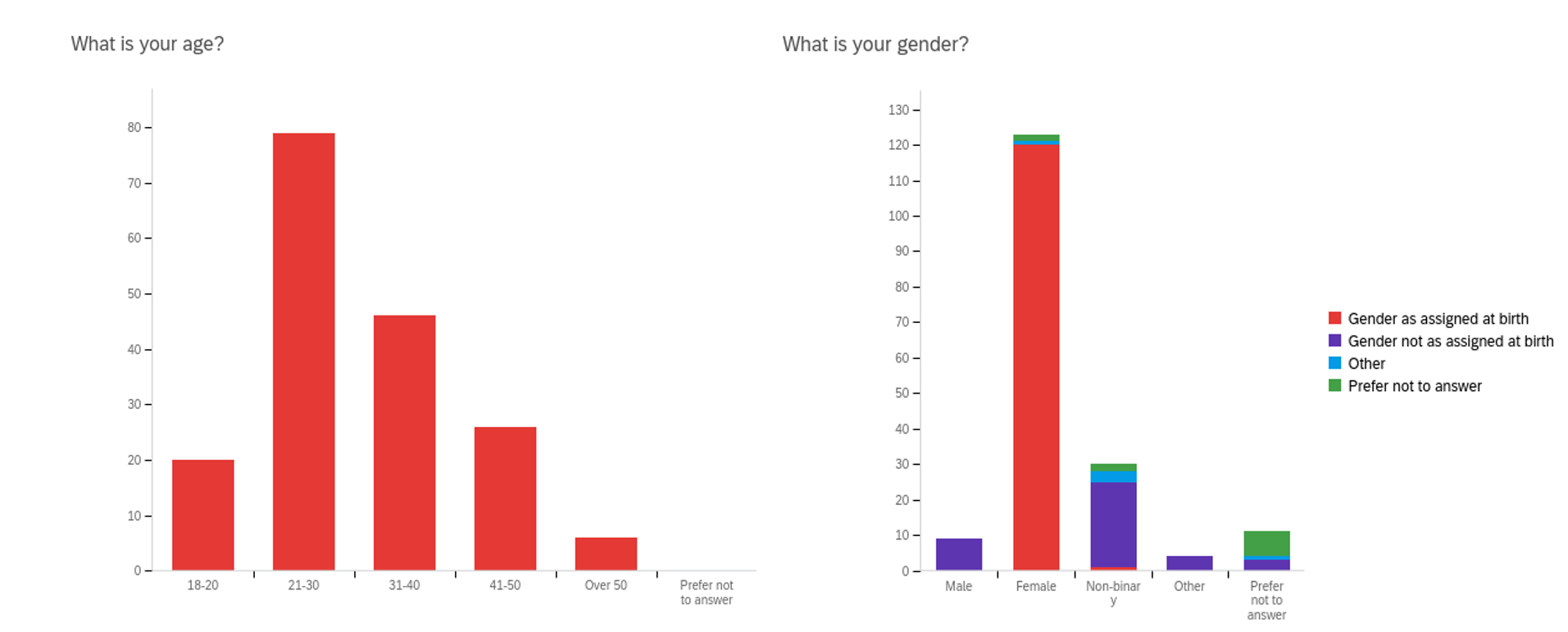
Figure 1. Age and gender distribution of survey respondents.
[4.5] We found that among our survey sample, there was overwhelmingly a positive attitude toward ownership of printed copies (figure 2) and the concept of fan binding. Of the 180 who had read Down to Agincourt, around a third (32 percent) reported that they own printed hard copies, with the majority of those who did not indicating that they would like to: of the 180, only nine respondents (5 percent) said that they were not interested in owning printed copies.
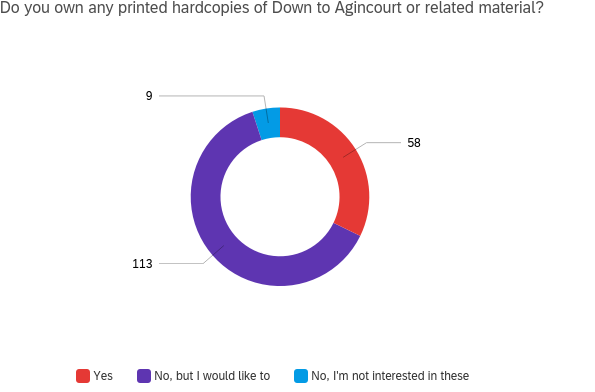
Figure 2. Ownership of printed Down to Agincourt copies.
[4.6] However, only ten of our respondents were responsible for designing their own fan-bound copies, whether through creating digital typeset files and/or covers or crafting their own hand-bound copies. The remainder own print-on-demand versions, most frequently those created by Mira or Wendy, with a smaller number owning the first 2015 edition (noting that respondents often owned multiple editions). This indicates that owning the copies is as much if not more of a motivation than the design and craft process itself for many fans. In fact, of the survey respondents who did create their own copies, three of them said they could not find any other printed copies available and so had no choice but to create their own. Nevertheless, others indicated that the process itself is sometimes part of the appeal.
5. Designing printed Down to Agincourt
[5.1] Wendy's first print-on-demand edition was shared in mid-2021. This edition features covers using public domain scientific images, including selections from the Trouvelot Astronomical Drawings, created by French artist and astronomer Étienne Léopold Trouvelot in 1882. The back cover also features the text of the poem Harry Takes the Field by Bratfarrar, which was inspired by book 1 of Down to Agincourt and was in turn the inspiration for titling the then-unnamed series. The interior, typeset in Sabon Next LT 10 point, also features illustrations.
[5.2] Through a mixture of typography, illustration, and detail, Wendy's second set of covers was designed to mimic or offer an homage to midcentury pulp editions of classic science fiction novels. They feature colorful titles and black-and-white images that include images of the characters adapted from screenshots of Supernatural episode 5.4 "The End." Incorporated into the design are several features intended to give the illusion that these are books that have been pre-owned and perhaps found serendipitously in a secondhand book sale. This includes trompe de l'oeil styling, which mimics creased edges (figure 3), and on the first volume, a price sticker that appears to have been added, overlaid, and then half removed. In the interiors, on the first page is a handwritten note that says "Property of Sam Winchester," completing the immersive idea that these books themselves were previously owned by one of the characters (and referencing a box of such well-loved sf classics that features in the narrative). The interiors are typeset in Baskerville Classico 10 point and include the same illustrations featured in the astronomical editions.
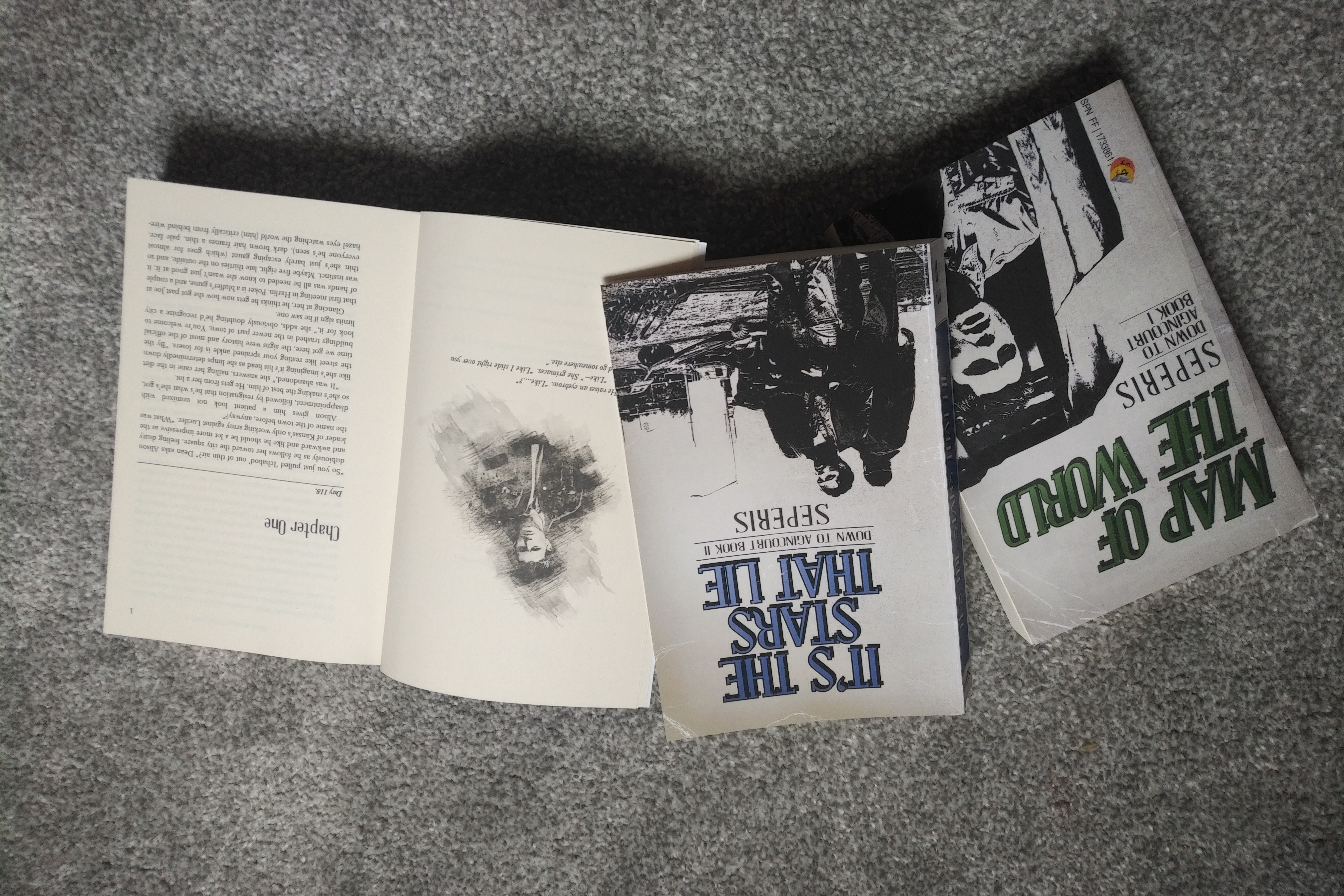
Figure 3. Pulp editions designed by Wendy. (Photograph supplied by authors and used with permission.)
[5.3] Mira, who agreed to be interviewed by us, also designed two print-on-demand editions, the first of which was also shared in early 2021, shortly after Wendy's first set. These were created initially as a gift, by request of her sister, but work in progress was shared with the Discord group who gave (primarily positive) feedback as they were developed. The covers of these editions utilize detail from classical artworks.
[5.4] Mira's second edition features solid dark blue covers with minimalist gold detail and spines that depict, when the books are displayed together, an abstraction of a slowly rising sun (figure 4). These were in part inspired by the 1946 edition of Edward Gibbon's Decline and Fall of the Roman Empire, published by Heritage Press, with spines designed by Clarence P. Hornung (The George Macy Imagery 2014), which show the slow crumbling of a pillar as the volumes progress. In this case, the sun's rising progress is, as described by Mira, symbolic of the series' emphasis on hope and the promise of human effort (as she puts it, "personal growth and change and community"). The interiors of these editions are typeset in EB Garamond and feature full-page interior illustrations and framing art at the start of certain chapters (figure 5).
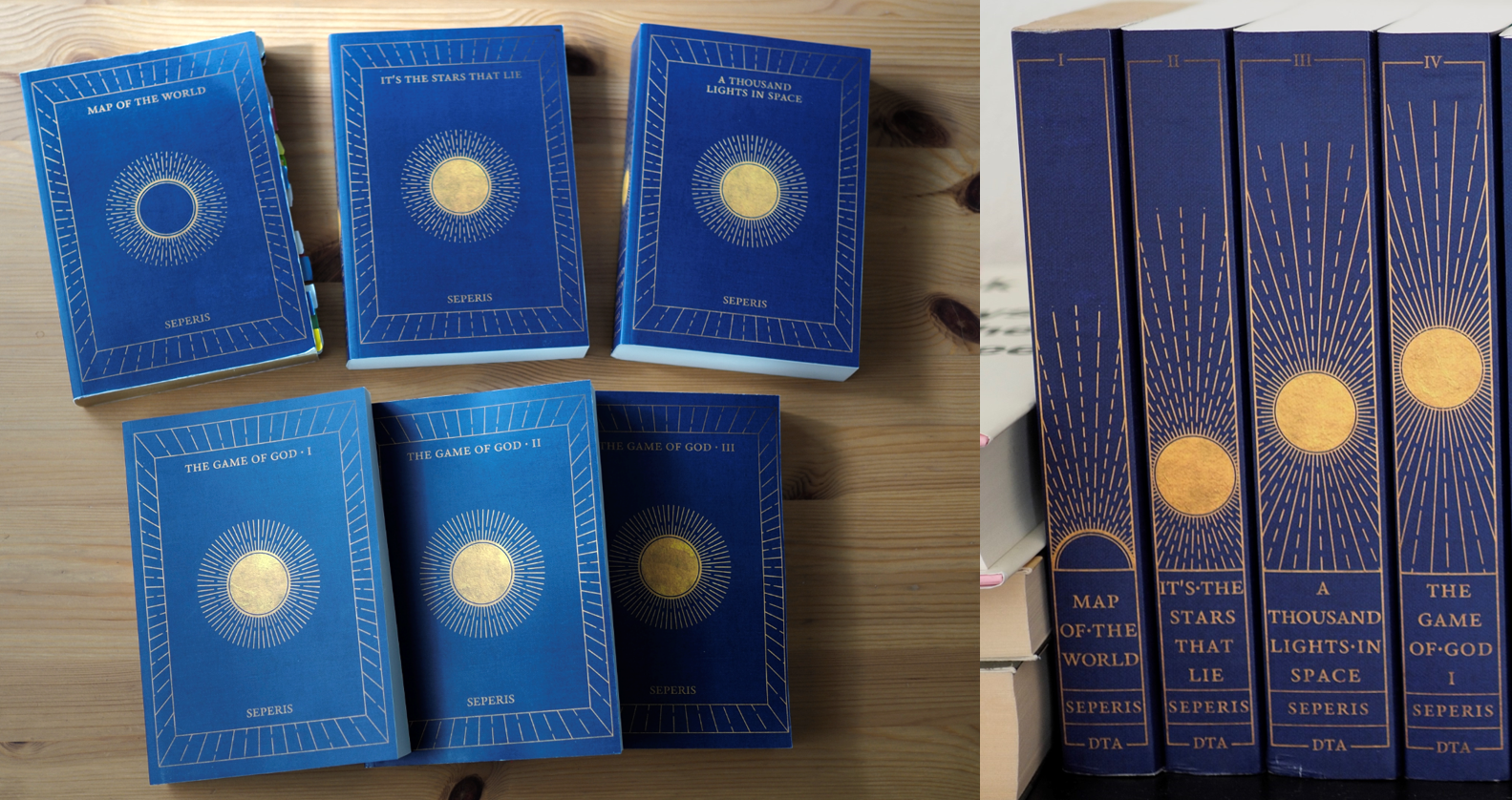
Figure 4. Sunrise editions designed by Mira. (Photographs supplied by Mira, used with permission.)
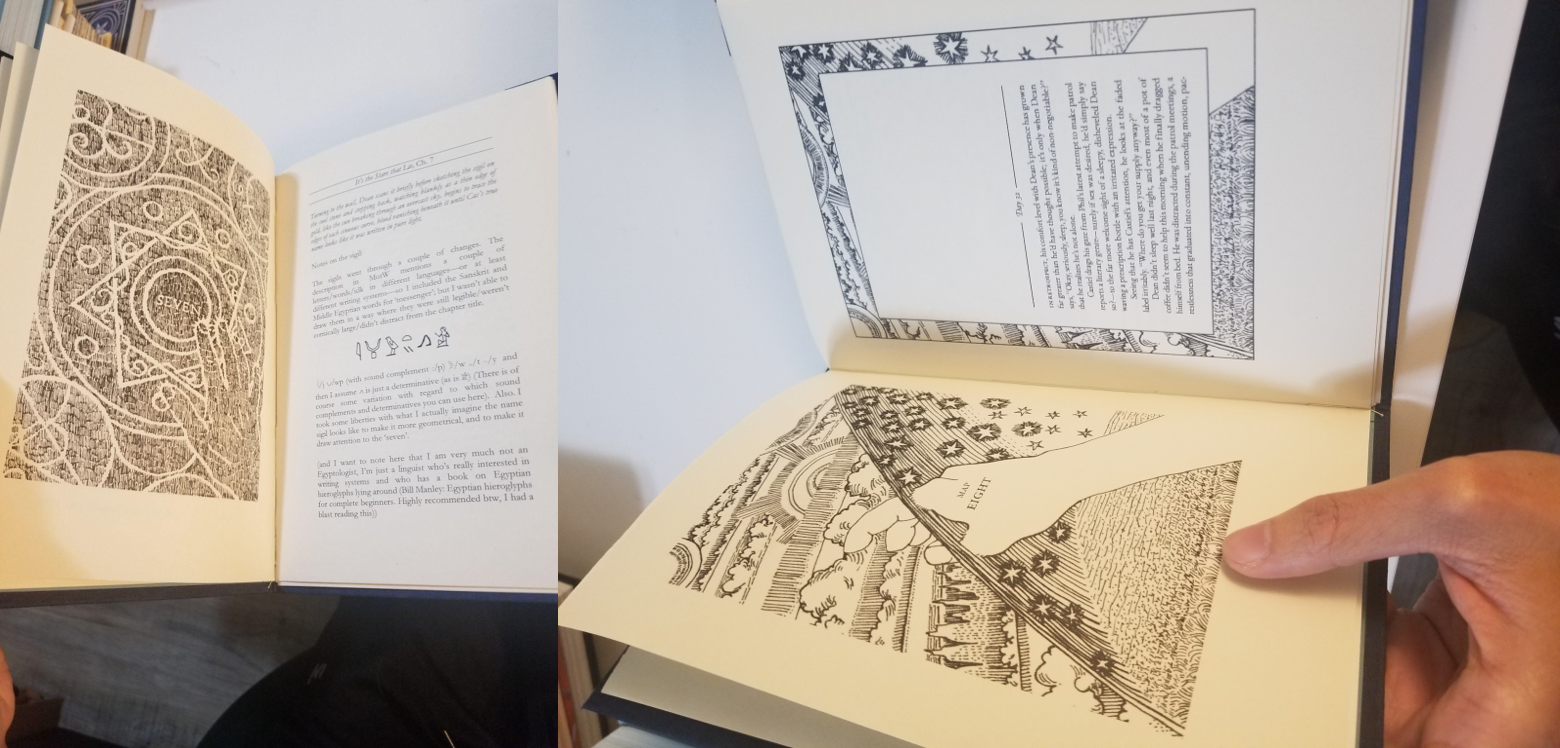
Figure 5. Bespoke binding of Mira's illustrations and annotations on their design, designed by Joe. (Photographs supplied by Joe, used with permission.)
[5.5] Mira typeset her editions using LaTeX, from her prior experience with academic writing, though she notes that "if I had known [what] it could be to, like, tackle over a million words, I might not have done it." After preparing the initial files, she found herself considering the practical implications of binding and making use of the physical affordances of books in crafting illustrations: "The pages are see-through anyway so you can do some design that uses that, or you split up illustrations…the preceding page makes you want to turn that page and use it as a physical book." From experimenting with type design, she became interested in typesetting for its own sake and has since read widely on design theory. In addition, her skill set extended to her modifying existing typefaces to add expert numeral sets and teaching herself to use photo editing software, as well as creating and automating a Python script to aid in the preparation of the manuscript. These skills have been used to create a new, longer, annotated edition. This one-off edition, for which the files have not been shared, includes extended margins allowing analysis, Seperis's own commentary, and items drawn from the AO3 comment sections to be placed adjacent to the text. It also features a handcrafted cover and other highly designed interior detailing.
[5.6] The choice of how or whether to include such supplemental information and metadata contained within the original AO3 version of the story is one that had to be made by each of the book designers. There may be multiple competing justifications to include or exclude metadata such as completism, utility of the information, and how presenting such information relates to the form of traditionally published novels. While most made use of the author's synopsis, only Mira added in AO3 tags and dates of publication, in a traditional colophon (figure 6)—an exception being Amanda, another of our interviewees, who eschewed typesetting in favor of simply printing out the AO3 PDF version.
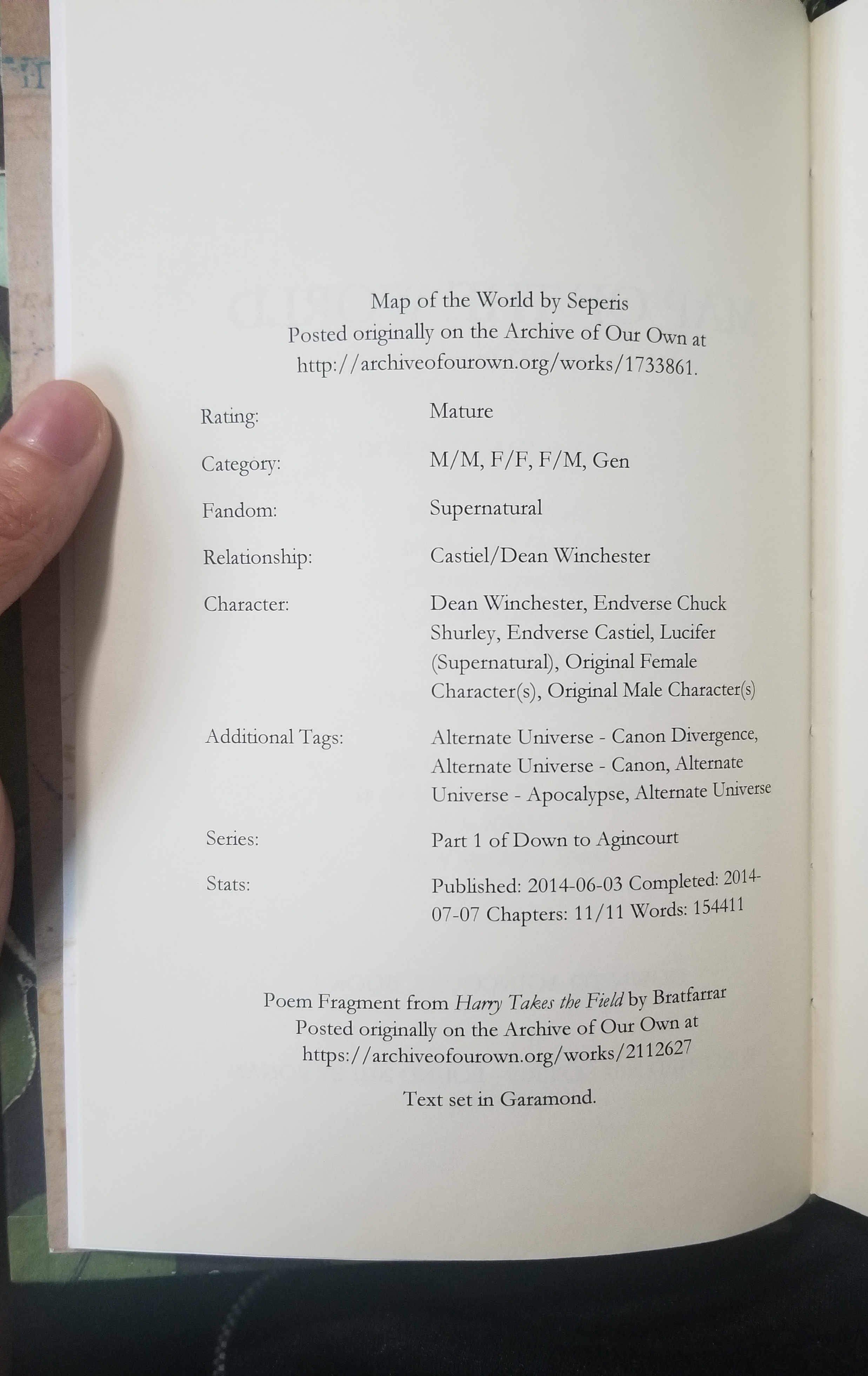
Figure 6. Metadata from AO3 included in one of Mira's editions. (Photograph supplied by Joe, used with permission.)
[5.7] Amanda taught herself practical skills such as gluing and stitching techniques for her handmade copies of Down to Agincourt and its adjacent works by Seperis, shown here with a selection of other fan fiction she has bound. These particular works are not typeset but are printed-out PDFs from the archive (figure 7).
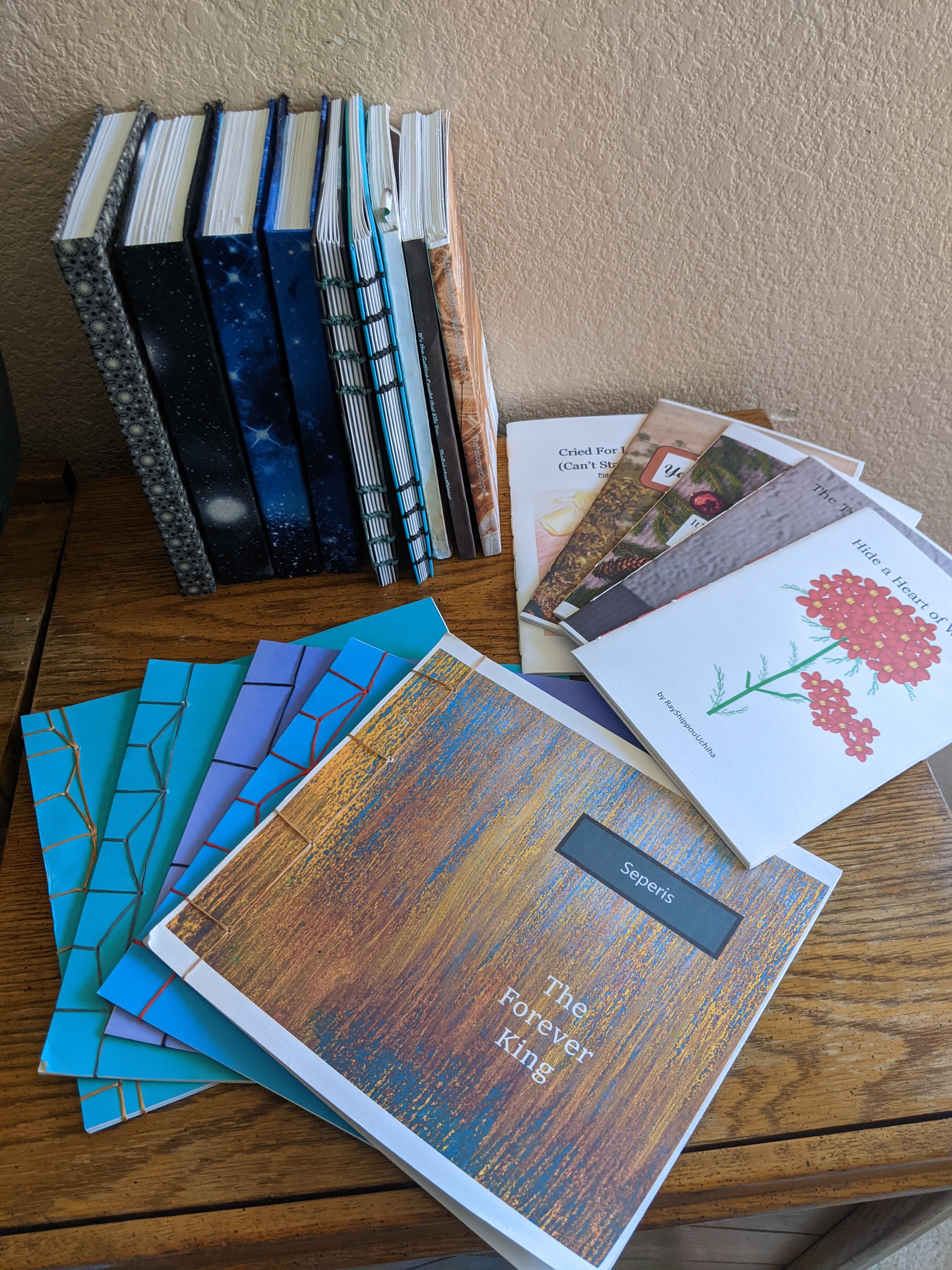
Figure 7. Selection of fan binding designed by Amanda. (Photograph supplied by Amanda, used with permission.)
[5.8] Learning new skills in design practice is an important part of fan binding. Amanda is not a member of any of the established fan communities surrounding Down to Agincourt and produced the books for her own collection, following instructional videos found online relating to bookbinding. Similarly, interviewee Teresa (who is also not part of the Discord communities) described how she taught herself techniques such as typesetting and gold foiling, using TikTok videos produced by other fan binders, as well as "lots of googling." Like Mira, Teresa, who mentioned the fact that English is not her primary language as a driver for creating a copy she could read and annotate, also created a book that collates and collects reader and author commentary on the story. To create her copies, Teresa adapted the covers created by Mira and also printed Wendy's covers to act as dust jackets.
[5.9] Interviewee Joe has created several different Down to Agincourt hand-bound copies using a variety of techniques including hand sewing using a kettle stitch and building a hardback case in which to glue the text block (figure 8), as well as supplemental material such as a collection of illustrations and artwork inspired by the series (figure 5). Joe is a member of the same community that Wendy and Mira belong to, where he has documented his development process through his creation of these books. This includes the process of sourcing materials, decision-making about the precise form and layout of the illustration and interior material, and decisions involved in creating unique endpapers, for example one set featuring a map with points burned out of it, referencing content in the story (figure 8).
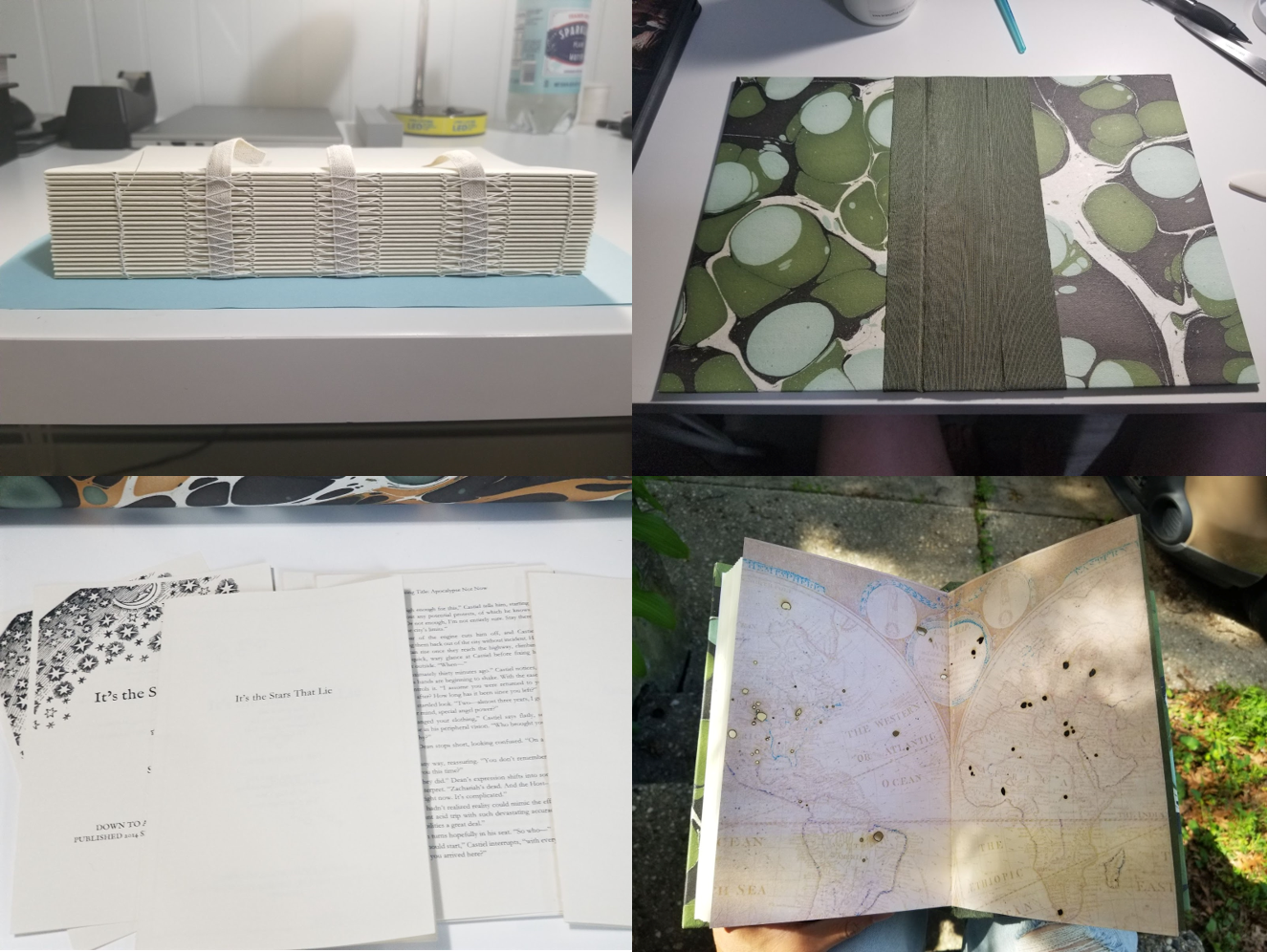
Figure 8. Clockwise from upper left: hand-stitched signatures, a hardback case to hold the resultant textblock, carefully burned endpapers, and typeset, illustrated front matter, all designed by Joe as part of his fan binding process. (Photographs supplied by Joe, used with permission.)
[5.10] Our interviewees mentioned typeface selection as being extremely important to them, and most chose a classic serif book font such as Garamond, possibly to emphasize Down to Agincourt's literary qualities. They also chose to include supplemental material as front and back matter and also in the form of illustrations, maps, and chapter headings.
[5.11] Each book's physical size was a further practical design decision, as was where to divide or split the text into multiple volumes, since both books 3 and 4, A Thousand Lights in Space and The Game of God, are too lengthy to fit into a standard book size. Additionally, choice of material played a part in binding decisions, since hand-bound books are generally hardcover; for print-on-demand books, the end user could choose between paperback and hardback, with or without a slipcover (files for each format being made available).
[5.12] Finally, book designers had textual choices to make regarding copyediting. The original AO3 version contains some typographical and other potential errors, which meant setting and adhering to standards as to what constituted an error to be corrected rather than an authorial idiosyncrasy or regionalism to be retained. Both Joe and Mira made use of a common document, a spreadsheet contributed to by users of the Discord server iteratively across editions, in an effort to crowdsource errata.
[5.13] While more than one interviewee mentioned the pandemic as a factor in both their reading of Down to Agincourt and their binding of it as an activity they could do during lockdowns, Joe described something our interviewees had in common: a special affective pleasure in creating. He stated, "The joy/power of being able to just create things I want to have is unbelievable, and I intend to use it whenever I can."
6. Fan binding ownership, affordance, and desire
[6.1] A key research question for our work was to consider what it is about printed books that appeals to fans enough to create or spend money on them. To understand this, we analyzed the survey responses, in which we found a clear theme of affect as a significant factor; fans had a positive affective response to the idea of printed fan fiction and to Down to Agincourt in particular. Out of our respondents who owned or were interested in bound copies of Down to Agincourt, more than thirty said they were not interested in owning other fan fiction works in this form, and when we asked why, several fans cited their stronger affective relation to this text, often coupled with an expression of desire to have it tangibly located "on their bookshelf": "There is something extremely rewarding and comforting in holding a physical book in your hands. Especially when it's a story you love."
[6.2] We found that there were also specific features of Down to Agincourt as a text that encourage the desire for printed copies. A large number of responses spoke about wishing to annotate the fic and noted that this was easier with a paper-based format. Many related this to the complexity and length of the story, with several also talking about their wish to reread the story multiple times. Seperis has noted in comments attached to the story that she did in fact write it to reward rereading, both as an exercise in style and as an example of the types of stories she likes to read.
[6.3] Joe described his appreciation for how hard-copy books offer specific affordances for engaging with the text: "I've had breakthroughs in the margins and connected dots I missed the first time around, which I may have still missed if I were reading online. I personally just enjoy being able to hold a book in my hands and flip through it, especially for cross-referencing. I tab significant details…and while it would probably be quicker and easier to just hit Ctrl+F on the story in question when looking for a passage in particular, I get a visceral joy in being able to flip back and look for it in the book."
[6.4] A second key aspect of desire for printed copies, alluded to above, was that of tangibility. Many survey respondents, like Joe, spoke about how the reading experience itself is different with a physical book, related to the physical affordances of a tangible volume—the reader may have an awareness of place in a story, such as where pages are physically located or where words appear on the page. Sensory experiences such as the feel, smell, and weight of books were also frequently mentioned. Several respondents talked about print reading being easier but also slower. This extended experience also characterizes rereading; the act of reading isn't merely a "one and done" event but something to be returned to, savored, and valued. Printed copies also have practical benefits; physical books can be read with no access to the internet or electricity, in various locations. Several respondents connected this to the recurrent themes of permanence and preservation by referring to more general fears of losing access to the book, perhaps due to technology failures but also risks facing the digital archive, including authors choosing to remove their work. There are also practical preservation considerations in the physical texts; Joe mentioned the importance of making future editions using acid-free, archive-quality paper that won't deteriorate as rapidly as standard paper. While these preservation aspects did not appear to be the main motivating factor for the majority of our respondents, they were something people seemed to be aware of, linking into comments about what might happen to the books in the long term, perhaps after the owner has passed away: "I will still have this book when I'm old (and I hope it really confuses the people who clear out my stuff when I die)."
[6.5] The following quotation builds on these ideas of permanence and also raises the idea of the book as an object of display, in this case a mysterious object that is recognizable to the respondent (and other fans) as representing their emotional tie to the work and the community surrounding it but opaque to those from outside the in-group who might see it and wonder at its provenance:
[6.6] I like the permanence of owning a hard copy, something which cannot be taken away. I have a hard copy that is signed by a group of friends who I met through reading the fic; that copy is a tangible representation of that community of people and the time spent together. I also like the mystery of having a book on the shelf which cannot be explained to a stranger without sitting down to unravel the extensive backstory, and how this one specific work made such a permanent impact on me, that I need to own a hard copy to somehow reflect that.
[6.7] This act of display is something we saw noted by many respondents, that including these texts on their bookshelves allows visibility either to the fans themselves (to evoke or reevoke emotions) or to signal to others the value of the book. Several respondents talked about this in terms of giving honor or dignity to the book or, in some cases, the author. This links to another major theme we saw from our results: the perception of a bound copy as being somehow more like a real book—"realness," as in "real literature," being a recurring theme in our respondents' answers—and that Down to Agincourt somehow offers an experience qualitatively different from other fan fiction, being something respectable to be placed on a bookshelf and displayed. This realness was sometimes seen as a function of the printed copies themselves, giving validity to the works in a way that the online archive does not. As one person remarked, "Printed books feel REAL, in my hands, a story I can hold close to my chest and see every day on my shelf."
[6.8] Joe mentioned a similar philosophy: "Guerrilla publishing [means] taking the fringe publications of fic and other non-traditionally published works, and presenting them like traditionally published works, to sort of subvert the concept of fanfic being seen as 'lesser than.'" However, there may be tension between this wish to display fan binding in context with traditionally published books and drawing attention to its provenance, which has an impact on decisions about the external appearance and design of the books.
7. Aesthetics and choice
[7.1] Although most of our survey respondents chose not to design their own copies, we still saw design as an important factor for these fans in obtaining books, with aesthetics and design mentioned often in responses to why people obtained their copies, particularly when several options were available and they were able to choose between them. Not all of our respondents were able to make this choice: three of the respondents were given their books as a gift so had no role in the decision-making. Others obtained the first version they were made aware of; for early readers, this was the only one available.
[7.2] The most commonly owned editions by our respondents were the pulp copies and the sunrise copies designed by Wendy and Mira, respectively. Respondents spoke of the visual appeal and attractiveness of the artwork and design, particularly of the covers. Some also referenced the relevance of the design and appearance to the content itself. As one suggested, "the covers/files should still represent the soul of the story as best as possible, no matter the style used."
[7.3] We saw this particularly in the pulp editions. These incorporate aspects that traditionally might be seen as negative, such as ersatz damage from wear and tear, but that "feel more authentic to the setting and aesthetic of the story." The sunrise covers, by contrast, were praised for their comparison to traditionally published books, with many responses again highlighting the realness afforded by the design. "I loved the way the Sunrise version looked side by side on a bookshelf with the rising sun illustration. The minimal design is very nice too and makes them look like real published books."
[7.4] This may particularly contrast to the pulp covers that use images of actors from Supernatural, which some fans found off-putting. We saw in our responses that readers often feel embarrassed or self-conscious about the identifiability that this lends to the books—which allows someone familiar with the television show to relate it and thus locate it as a piece of fan fiction (or at least tie-in content)—and expressed a desire for a more covert copy. Several respondents mentioned that the anonymity of the books was important and that they would not want other people to be able to identify the nature of the work, especially in public (note 4).
[7.5] Considerations of form and function as physical, readable books were also important. People appreciated when practical design choices made by the books' creators suited their own needs. Such design choices include not only the page, font, and margin size but also decisions about where to split some of the larger books that can only be comfortably printed (and held) if divided into a number of volumes. Wendy also provided detailed instructions on how to use the print-on-demand service alongside the document files, which was also mentioned by some respondents as being appreciated in making the process easy.
[7.6] Beyond the design considerations, our respondents often noted that price or affordability influenced their decisions of which edition to obtain, choosing cheaper versions. The least people reported spending on their copies was around $5 and the highest $370, with most fans spending in the range of $30 to $70 on their books and one respondent noting that "getting them printed and shipped wasn't any more expensive than buying any other book."
[7.7] Choosing between the multiple available editions was difficult for some fans, with who "asked my friends to vote which one since I couldn't decide." In fact, we saw that many respondents did not in fact choose between editions, owning multiple copies. It is likely that some fans want to own both pristine display copies as well as more utilitarian objects for repeated reading and annotation, as described above. This is a strong indication that the books are not just desired for reading but are themselves desirable art objects.
8. Discussion and conclusion
[8.1] In this article, we have taken a focused look at a specific fan community to more deeply examine motivations and practices of fan binding. This has allowed us to examine questions such as why readers want to own printed books. Answering this question is not simple and involves many interacting factors. Perhaps the first and most important of these factors is affect—that people feel a strong emotional bond to both the text and the medium of printed books; like other material object fandom, this response may be difficult to pin down or describe. As Woo (2018, 166) quotes one fan's description of a cherished D&D text, "Just even to open the copy, it's the artwork, it's the feel of the book, the size, the shape, it's everything that goes along with it." We found that people who create fan binding do so for their own pleasure, with design decisions based on their preferences and desires for particular aesthetics and affordances. But we suggest that fan binding is an example of a manuscript itself being a transformative work, in a similar way as described by Porter (2019). The creative practice of transforming a digital text into a physical designed object creates new artistic work in the same way as, for example, fan art, in which the process includes making transformational choices about what is included or excluded (e.g., metadata). These works, which resist the norms of traditional publishing as transformatively created real books, then enter the fan gift economy and may be shared within the community. This echoes Wilson's (2021, ¶ 4.3) description of "the circulation of texts as objects of exchange or gifts within an exclusive reading community, the materiality of such texts as objects of care, the structures of feeling within and around texts, or the self-fashioning of members of a particular reading community around their textual affiliations."
[8.2] This community aspect to owning fan-bound copies is expressed in the material objects themselves. Such ownership can be part of a group activity or experience, offering shared cultural capital and participation in a fannish gift economy. With covers that don't particularly announce the text's contents, fan volumes bound with abstractions can be seen as enclosing a mystery, which can be a talking point among fans as well as an in-group signifier. The hidden meaning encoded in the covers may be desirable to their owners to the extent that more transparent versions (including recognizable actors) may be disfavored. This relates to van der Weel's (2010, 54) comments that books can carry identity: "The symbolic meaning of the book imbues its readers with a certain affective and social status. Even a sense of identity might be said to attach to books; hence the persistence of the old saw 'show me your book case, and I will tell you who you are.' What is important in all these cases is the visibility of books, resulting from their materiality, and the obvious ownership relation projected by this visibility." While owning print versions of text may come with in-group social status and personal, positive emotional attachment to their display, this visibility may be too revealing for some whose fannish identity is preferred hidden.
[8.3] While many fans design and create fan-bound copies purely for themselves, not all fans possess the time, skills, resources, or desire. However, we also saw production as part of a community activity. Knowledge and expertise were shared, with community feedback throughout the process and longitudinally over time. These ongoing contributions formed a collaborative iterative design process; earlier volumes influenced design decisions made in later editions, with community input incorporated into subsequent versions. This tangible community production included crowdsourced errata tracking and coproduction of annotated editions and collected illustrated material. We would additionally like to suggest that even when fans are only purchasing or printing out a bound work of fan fiction and not contributing to creating or producing it themselves, the act of consumption is in itself a transformative act. Mira, for example, mentioned her frustration when people wanted to pay for the files or offered to buy copies, in effect trying to commercialize the transaction; while fan binding may be consumption in terms of material ownership, it is very much outside the realm of capitalist exchange, with a collaborative process around creation as well as an exchange that takes place firmly within a fannish gift economy. Woo (2018) compares curating a collection to the rearrangement of characters into a piece of fan fiction and notes that "collectors are indeed producers, makers, and doers." Several fans in our survey appeared to recognize this practice, noting that these books are something that they wish to add to their personal collection for display to themselves or others.
[8.4] The material properties and affordances of books as objects are also critical to understanding fan binding. Aesthetic appeal is a key factor; in fact, some people bought bound copies before they had even read Down to Agincourt, influenced by the covers or other features of binding. There is a design aspect to these fan binding objects that is recognized by those making as well as those consuming. As one of our respondents noted: "The printed version has a lot more deliberate design elements than the digital version." This suggests that something about the design aspect may be missed in an online reading experience.
[8.5] Some physical affordances present in printed copies cannot be replicated digitally. These include tangible, sensory experiences associated with reading a book, which may be in themselves desirable. Our respondents talked about the immersive experience of paper reading. The act of reading itself becomes inscribed in a paper book in a way that static digital files do not allow; kudos can only be left once, but a book changes with every reading as the paper folds and creases and the spine cracks at treasured passages. Godwin (2020, 136), in discussing material practices around fans consuming food and drink, noted that "immersion motivates many material fan practices." In fact, in a supplemental question in our survey we saw that many Down to Agincourt fans also participate in other material practices, including eating and drinking items directly inspired by the books or that have gained significance through association.
[8.6] Many of our respondents also specifically talked about affordances relating to their wish to interact with the text in particular ways—for example, to annotate, analyze, engage with, and reread the text. This goes beyond the emotional engagement fans have with fan fiction texts and suggests specific qualities of a work encourage such engagement and the idea that deeper reading may be possible with a printed text (Phillips and Kovač 2022). In this study, we have found that fans consider the complexity, literary qualities, and length of Down to Agincourt as particularly meriting the transfer to a tangible form. There is potential for further research, looking at a broader selection of fan-bound works, to consider whether works that tend to be more commonly bound and/or distributed share common features.
[8.7] In considering so-called realness, which we found to be a key factor of fan binding, we must consider both content and form. Many of the Down to Agincourt fan-bound editions have a publisher's mark incorporated into the design. This may simply be a mimicry of historical publishing, but it is also perhaps an expression of taking ownership of the practice of curation and quality that would traditionally have been associated with publishing houses. This also serves the purpose of acknowledging the volume's status as a transformative work, which has tangible input from the publisher who has put time and skill into the design work necessary to create these objects. The desire to realize suggests issues of status and respectability; as Coker (2017) points out, printed books are considered the objective form of a book in a way that may act to diminish others. These books also may be a reaction to the frustration at limited traditional publication and distribution options for these texts that are ineligible for file-off-the-numbers redistribution outside the fannish gift economy.
[8.8] It must, however, be noted that fan-bound printed copies do not negate or diminish the existence of digital copies in the archive that have their own affordances, unreconstructable in the printed form. In our analysis we have seen that designers creating printed copies must make choices about the inclusion of metadata, and most included only a limited selection of that which is associated with the original digital version, if any. Down to Agincourt as published on the Archive of Our Own is a living, fluid text not only because it is a work in progress and still incomplete but because of its community contributions that include reader comments and work inspired by and connected to the series. Both printed books as fixed preservation and digital texts as living organism have value in this case.
[8.9] What we have seen, however, is that there is a strong desire on the part of many fans to own physical books of beloved fic—so much so that even those who do not have the skills, knowledge, or drive to create their own books still wish to acquire them through other means. In these cases, aesthetics, design, and community involvement can be strong factors in choosing between several different options, or fans may simply seize upon the first opportunity that arises. In whatever ways that fans create or acquire their copies of books, fan binding is an act of care and love, as well as personal desire made material.